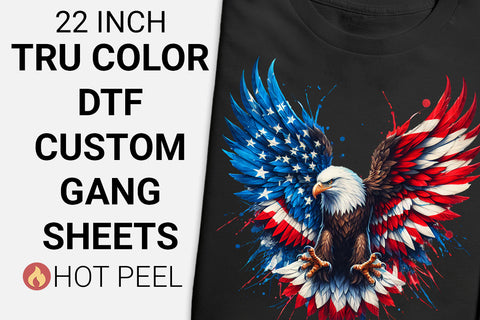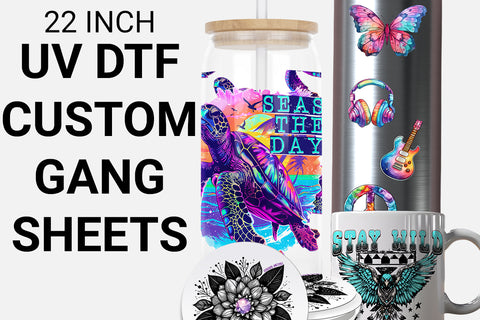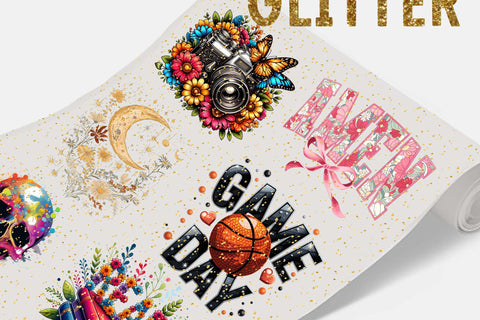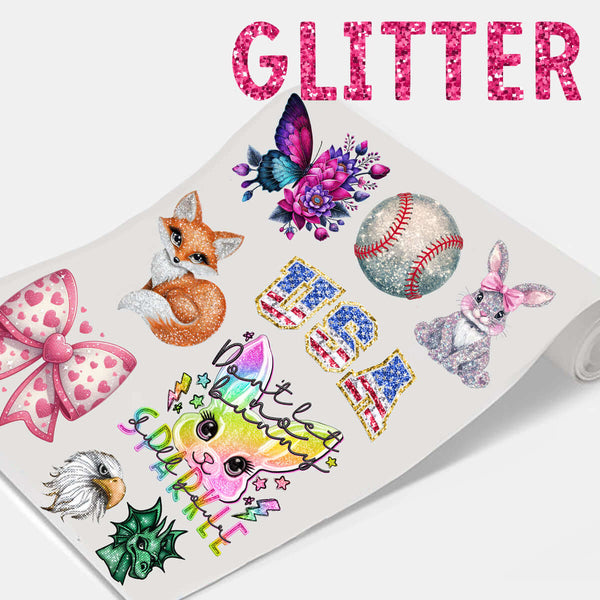Are you curious about the difference between DTF and UV DTF printing? DTF printing transfers designs to fabrics with only heat and adhesive powder. UV DTF uses UV curable inks and AB film to print directly on hard surfaces like glass, metal, or acrylic.
In this guide, we will explain the important differences between DTF and UV DTF. We will let you know what materials each is best suited for and how to choose the right one for your next printing project!
Table of Contents
- What Is DTF (Direct-to-Film) Printing?
- What Is UV DTF Printing?
- UV DTF vs. DTF Printing
- Why Local Businesses Are Combining UV DTF and DTF Printing
-
DTF or UV DTF: Which One Should You Choose?
- FAQs About DTF and UV DTF Printing

What Is DTF (Direct-to-Film) Printing?
DTF is a process by which ink designs are printed on fabrics from PET films through the use of heat and adhesive powder. It is widely popular with custom decorated apparel, including t-shirts, hoodies, and tote bags plus many other fabrics ranging from cotton, polyester and blends of these fabrics.
How DTF Printing Works:
- Print your design on a clear plastic PET film with DTF ink.
- Hot melt adhesive powder is applied to the printed film.
- Cure with heat to a set temperature where the powder melts into a glue layer.
- Press with heat from a heat press onto the fabric you are transferring to. Let cool and peel off the film and your done!
Pro Tip: Always pre-iron your fabric before heat transferring, it will take the moisture out and allow you to have a cleaner transfer.
Why people love DTF:
- Works on cotton, polyester, and blends
- Colors stay bright after many washes
- No weeding or cutting needed
- Wonderful for short runs and custom designs
What Is UV DTF Printing?
UV DTF printing uses UV curable ink that prints directly to the film with UV light. UV DTF is for hard surfaces which include, but are not limited to glass, metal, plastic, wood, and acrylic. If you’ve ever seen a tumbler, key chain, or phone case with a glossy raised logo, that’s UV DTF.
How UV DTF Printing Works:
- Print your image on UV DTF film using UV inks.
- The printer uses UV light to cure the inks immediately.
- Apply transfer film.
- Peel and stick to your surface, remove film.
- There you have it! No heat press, no powder, no mess!
Why people love UV DTF:
- Works on glass, metal, wood, acrylic, and plastic
- Water resistant and scratch proof
- No heat pressing needed, just print, cure, and stick!
- Glossy raised and professional looking finish!
UV DTF vs. DTF Printing
Let’s look at how these two methods compare side by side.
|
Feature |
DTF Printing |
UV DTF Printing |
|
Ink Type |
Water-based pigment (CMYK + White) |
UV-curable (CMYK, White, Clear) |
|
Best For |
Fabrics and apparel |
Hard surfaces (glass, plastic, metal, wood) |
|
Adhesion Method |
Heat press + adhesive powder |
UV light curing, no powder or heat |
|
Workflow |
Multi-step (print, powder, press) |
Faster, simplified |
|
Durability |
Washable, stretchable |
Scratch-proof, waterproof |
|
Startup Cost |
Lower startup cost |
Higher initial cost, becoming affordable |
|
Finish |
Soft and flexible |
Glossy, raised on hard surfaces |
1. Material Compatibility
-
DTF: Works great on soft porous materials such as cotton, polyester, or blends. Great for clothing.
-
UV DTF: Made for hard non porous surfaces such as glass, plastic, metal, and wood materials that traditional DTF cannot handle.
2. Adhesion Process
-
DTF: Uses adhesive powder and heat to keep the inks to fabric.
-
UV DTF: Uses UV light to cure the inks directly to the film, no powder or adhesive presses needed.
3. Production Speed and Workflow
-
DTF: Slower due to multiple steps (printing, powdering, curing, pressing).
-
UV DTF: Faster and more efficient, no baking, no powdering, and minimal cleanup.
4. Durability
-
DTF: Prints are soft, flexible, and wash-resistant, ideal for clothing that stretches or folds.
-
UV DTF: Prints are waterproof and scratch-resistant, suitable for hard objects and signage, but less flexible.
5. Cost Considerations
-
DTF: Lower startup cost for equipment and consumables (ink, film, powder). Great for startups and apparel businesses.
-
UV DTF: Higher upfront cost due to UV printers and inks, but faster production and premium finish can offset the investment.
6. Print Feel and Appearance
-
DTF: Soft and smooth blends into the fabric with a matte finish.
-
UV DTF: Glossy or raised texture that feels more like a decal.
7. Ink Type and Colors
-
DTF: Water-based pigment inks (CMYK + White).
-
UV DTF: UV-curable inks (CMYK, White, Clear) for layered, textured effects.
Why Local Businesses Are Combining UV DTF and DTF Printing?
Many local printers and small businesses are picking up DTF and UV DTF printing together to provide their clients with a complete selection of custom products.
- Use DTF for apparel, T-shirts, sweat shirts, tote bags and uniforms.
- Use UV DTF for hard goods. Mugs, tumblers, bottles, key holders, packaging and signage.
By using both, you have the option of printing on just about any material, broadening your product line, increasing earnings — all without the need for sublimation or vinyl.
DTF or UV DTF: Which One Should You Choose?
When deciding on UV DTF vs. DTF printing, you need to look at what your targeted materials and your goals are for your business:
Choose DTF printing if the bulk of your focus is on apparel and other soft fabrics.
Choose UV DTF if you want to be able to personalize hard goods, tumblers, mugs, packaging, or electronics.
In 2025, both technologies are more accessible and affordable than ever.
These days, DTF and UV DTF are simpler and cheaper to run. Use both, and you can print on just about anything shirts, bottles, packaging, you name it.
Ready to start printing? Here at DTF Virginia, we provide quality DTF transfers, printing supplies, and guidance to help your business stand out.
FAQs About DTF and UV DTF Printing
What’s the main difference between DTF and UV DTF?
DTF uses heat and adhesive powder to print on fabric, while UV DTF uses UV-cured ink to print directly on hard surfaces like glass or metal.
Is UV DTF better than DTF?
Not necessarily — it depends on your use. UV DTF gives a premium, glossy finish for hard goods. DTF gives soft, flexible prints for apparel.
Can UV DTF be used on shirts or fabric?
No. UV DTF doesn’t bond well to soft materials. Stick to DTF for clothing and textiles.
Which printing method lasts longer?
Both are durable in their category — DTF resists washing and stretching; UV DTF resists water, sunlight, and scratches.
What equipment do I need for DTF printing?
You’ll need a DTF printer, PET film, DTF inks, adhesive powder, and a heat press.
What equipment do I need for UV DTF printing?
A UV DTF printer, UV-curable inks, UV lamp, and transfer film — no heat press required.
Is DTF or UV DTF cheaper to start with?
DTF has a lower startup cost, making it ideal for beginners or apparel businesses.
Can I use both methods in one business?
Yes, many print shops use both to serve apparel and hard-good markets. It’s a great way to expand your product range.

























